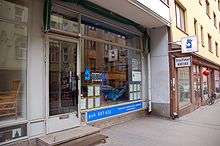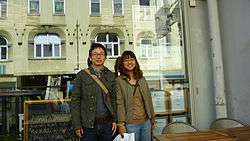Kamome Shokudo
| Kamome Shokudō | |
|---|---|
 | |
| Directed by | Naoko Ogigami |
| Produced by | Mayumi Amano |
| Written by | Naoko Ogigami |
| Starring |
Hairi Katagiri Satomi Kobayashi Tarja Markus Masako Motai Jarkko Niemi Markku Peltola |
| Music by | Tatsuro Kondo |
| Cinematography | Tuomo Virtanen |
| Edited by | Shinichi Fushima |
| Distributed by | Nippon Television Network Corporation |
Release dates |
|
Running time | 102 minutes |
| Language |
Japanese Finnish |
Kamome Shokudō (かもめ食堂 Kamome shokudō) is a 2006 comedy film written and directed by Japanese director Naoko Ogigami, It's based on a novel by Yōko Mure. The film is set in the Finnish capital Helsinki, and follows a Japanese woman who sets up a diner serving Japanese food in the city, and the friends she makes in the process.
Cast members include: Hairi Katagiri (Midori), Satomi Kobayashi (Sachie, the shopkeeper), Masako Motai (Masako), Markku Peltola, Tarja Markus (Liisa), and Jarkko Niemi (Tommi).
Plot
Sachie is a Japanese woman living alone in Helsinki, who is trying single-handedly to establish a new cafe serving Japanese-style food. However, it has no customers. Eventually a young Finnish anime enthusiast comes for coffee and becomes the cafe's first regular, though as her first customer he gets to eat and drink there for free.
Midori is a Japanese woman who has just arrived in Finland for an indefinite time and without any definite plans. She and Sachie happen to meet in a bookstore and she starts to help out in the cafe. Later, Masako, another Japanese woman on her own, turns up. Her baggage has been lost by an airline, and before long she too starts to work in the cafe. Over the course of the film, the cafe gradually gains more customers, and the Japanese women make more friends with the local people.

Reception
It was the 5th Best Film at the 28th Yokohama Film Festival.[1]
Tourist attraction
The film was filmed in a real cafe in downtown Helsinki, at the address Pursimiehenkatu 12, its real name being Kahvila Suomi (Finland Cafe). However, the original decor of the cafe was taken out for the filming, replaced by Finnish designer furniture. The original interior was returned afterwards. A poster from the film remains in the window of the cafe and it has become a popular tourist attraction for Japanese tourists.[2]
References
- ↑ 2006年日本映画ベストテン (in Japanese). Yokohama Film Festival. Retrieved 2009-12-31.
- ↑ My Helsinki - Kahvila Suomi